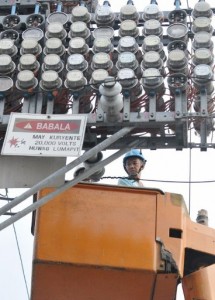Higher electricity bills seen this month

Customers of Manila Electric Co. can expect their electricity bills to go up in January due to the higher cost of power from the wholesale electricity spot market. AFP PHOTO/JAY DIRECTO
Customers of Manila Electric Co. (Meralco), the country’s biggest power distributor, can expect their electricity bills to go up in the first month of 2013 due to the higher cost of power from the wholesale electricity spot market (WESM).
An Inquirer source privy to Meralco data said that although the WESM bill to Meralco dipped slightly during the supply month of December due to “negative adjustments,” the underlying WESM price went up. The increase helped prop up the final generation charge—which reflects the cost of electricity sourced by the utility from power-generation companies.
It was not made clear whether the cost of electricity from other sources like independent power producers (IPPs) and the state-owned National Power Corp. also went up.
Based on data from the WESM, the December 2012 load-weighted average price (LWAP) ended up 64 centavos a kilowatt-hour higher than the LWAP in November 2012.
Although power consumption was relatively stable in December, supply was tight due to the forced outages at the Masinloc power facility and the scheduled outages at the Ilijan and Sta. Rita natural gas plants, where Meralco sources a portion of its electricity requirements.
Article continues after this advertisementAs a result of the reduced output from coal and natural gas plants, generation from the more expensive oil-fed power facilities increased.
Article continues after this advertisementMeralco is set to announce the generation charge for January anytime this week.
The power firm has always stressed that it does not earn from generation charges. Payments for the generation charge, which is a pass-through cost for Meralco, goes to power producers such as Napocor, the independent power producers (IPPs) and the WESM.
The company’s own rates—in the form of distribution, supply and metering charges—account for only 16 percent of the total electricity bill.
Last month, Meralco customers saw a reduction in their electricity bills due to reductions in the generation, transmission and system loss charges.
Generation charges were cut by 31 centavos a kWh while the transmission charge to residential customers fell by 11 centavos a kWh due to the lower ancillary rates of National Grid Corporation of the Philippines, which operates the country’s transmission network. The lower generation and transmission charges resulted in a drop of 4 centavos a kWh in the system loss charge for this month.